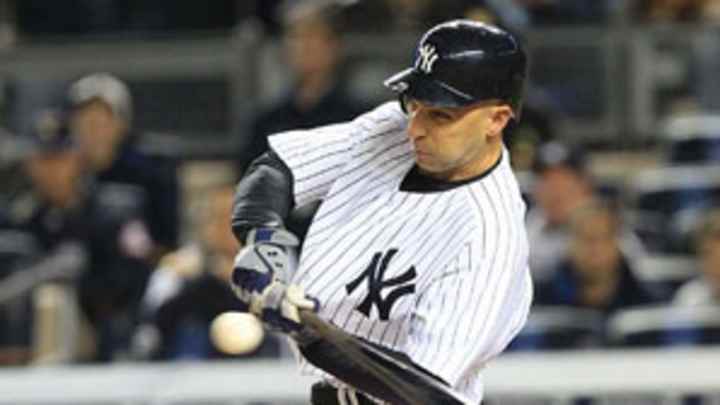Ibañez authoring fascinating twist in remarkable career story


He hears the voice, still. He heard the voice when he stepped up to the plate and hit those two home runs against the A's three weeks ago, that crazy, unbelievable day in the Bronx when the madness began. He heard the voice when he stepped up to the plate and hit those two improbable home runs against the Orioles in Game 3 of the ALDS, and he heard the voice on Saturday night when he saw that 85-mph splitter from Jose Valverde and ripped the two-run ninth-inning home run that tied Game 1 of the ALCS.
This week, when he's at the plate, inevitably, in another huge October moment, against Justin Verlander or Max Scherzer or another Tigers pitcher, when his old and weary and crumbling lineup needs him again, when the folks at TBS flash a graphic with his video game numbers from his amazing Reggie Jackson-like October, when the raucous white-towel waving faithful are on their feet and roaring and it's one of those moments you can feel Comerica Park shake, when everyone, everywhere, will be saying, He can't do it again... can he?, Raul Ibañez, the new Mr. October, will step up to the plate and block everything out, and he'll see the pitch and there will be nothing but the voice.
* * *
This isn't luck, a miracle or magic. This is Raul Ibañez, the player he's always been. Anyone who knows the player, anyone who's followed him since the early years in his long, strange career, would tell you that. They'd tell you that there's no hitter on the planet streakier than Raul Ibañez, they'd tell you that when he's cold he's as cold as winter in Buffalo, and when he's on a roll he is capable of carrying a team. They'd tell you that if Joe Girardi were smart, he'd ride this as far as he can.
These are desperate times for the Yankees, as you know. The Captain is down. Alex Rodriguez, Robinson Cano and Curtis Granderson are a combined 1-for-24 with nine strikeouts against the Tigers. The Yankees are down 2-games-to-0, and headed to Detroit, with Justin Verlander and Max Scherzer and the rollicking Tigers fans at Comerica Park waiting.
Ibañez -- a 17-year journeyman who's become the postseason cleanup hitter for a $194 million team, who at 40 has become an October legend -- has been the one-man wrecking crew for New York. You can call his postseason story inspiring, or unbelievable. But don't call it a fluke. Ibañez goes through stretches like this -- after all, this is a player who hit 17 home runs in his first two months as a Phillie in 2009. This postseason, he's been on fire at the right time, hitting .438/.550/ 1.063 with three home runs and a double. But he was also on fire to finish the regular season, too: starting with that Sept. 22 game against the A's in which he came off the bench to hit two home runs and a double in the Yankees' 10-9 win, Ibañez hit .405, slugged .450 and hit four home runs.
It's not a miracle, what he's doing this October. No, the miracle in The Raul Ibañez Story happened 11 years ago.
* * *
"I'd be lying if I said I always thought for sure things were going to work out, that at my age, I'd even still be in the game today."
This was 2009. Raul Ibañez was having lunch at a Manhattan restaurant, explaining his great start to his first season with the Phillies. He talked about many things that day -- his love for chess, his addiction to The Office, his family, his teammates, all the people who helped him along the way. He also talked about the moment his career hit rock bottom.
Ibañez was 29, a backup outfielder for the Royals, a .240 career hitter with less than 500 at bats at the major league level, when he got the news in May 2001 that he was headed for the minors. "It was the second time that year that they had put me on waivers, the second time I'd been unclaimed by every single team," he says. "That was rock bottom for me."
In desperation Ibañez called up Kevin Seitzer, a former Royals All-Star third baseman that a teammate had mentioned was giving hitting lessons in the area. Before he was due to report to Triple-A Omaha, Ibañez met Seitzer at an indoor hitting facility in Overland Park, Mo., and it was there that Seitzer completely remade Ibañez's swing and hitting philosophy.
"The player that I saw then was very strong with extremely quick hands, talent oozing out of him," says Seitzer. "But he was so tight at the plate and he yanked everything. He had no concept whatsoever of taking a fastball and hitting it the other way."
Seitzer advised Ibañez to shorten his stroke, not swing as hard as normal and to aim to line the ball the other way, in the direction of the shortstop, on every pitch. Eighty percent, nice and easy, Seitzer would say. After three grueling days in the cages, Ibañez called Seitzer up and said, "I can't do this anymore. My hands feel like hamburger."
But Seitzer's voice stayed with Ibañez in Omaha, where he saw the results immediately; it stayed with him to Kansas City, where he was called up later that summer and thrived filling in at first base and the outfield for injured regulars; it stayed with him in Seattle, where he was traded in 2004 and where, between 2006 and '08, he was a .290 hitter averaging 26 home runs and 113 RBIs a season; in Philadelphia and in New York, where he landed this spring after he signed a one-year, $1.1 million deal.
"Seitzer's voice is still with me," said Ibañez. "It'll be with me every time I step up to the plate."
"Nothing Raul does surprises me at all," says Seitzer. "As focused as he is, as great of shape he's in, it wouldn't surprise me if he's still hitting home runs, and playing productively, until he's 43, 44, 45. Raul, he's a different kind of animal."
Ibañez's work ethic comes from his father, Juan, who was an accomplished chemist in Castro-ruled Cuba before fleeing his native country in the late 1960s. Juan and his family landed in New York City, where Raul was born, before moving to Miami, where Juan worked 70-hour weeks, toiling in menial jobs for a cruise line company. "Not once did I ever hear him complain," Raul said. "Not only did he never call in sick, he showed up to work early." Juan died in 1992, just months after Raul, a standout first baseman at Miami Dade Community College, was drafted by the Mariners.
When Ibañez broke into the majors at 24 with the Mariners, he was surrounded in the locker room with outsized stars -- Ken Griffey Jr., Alex Rodriguez, Randy Johnson. But the players Ibañez watched most closely were pitcher Jamie Moyer and designated hitter Edgar Martinez, a pair of veterans in their mid-30s who got better with age. "What I saw were two guys who were working harder than everybody else," said Ibañez. "Edgar would sit at his locker, staring at cards to work on his eye conditioning. Every day."
Ibañez still calls Martinez for hitting tips, and still talks to Moyer, who became a first-time 20-game winner at age 38. In their Seattle days, when Ibañez was a pull-happy hitter whose career looked like it was going nowhere, he'd every so often pull up a chair to Moyer's locker and say, "Tell me the Jamie Moyer Story."
"I looked at Jamie and Edgar and always thought, 'That's how my career is going to go,'" said Ibañez. "As far as I was concerned, they had model careers. I was always amazed and inspired every time I heard the Jamie Moyer Story."
Now, of course, everyone wants to hear the Raul Ibañez Story. They want to hear about how a journeyman became the postseason star for a $194 million team, how a 40-year-old became an October legend.
Can Ibañez save the Yankees again? Pull up a chair. See what happens in Detroit. The Raul Ibañez Story may not be over yet.
